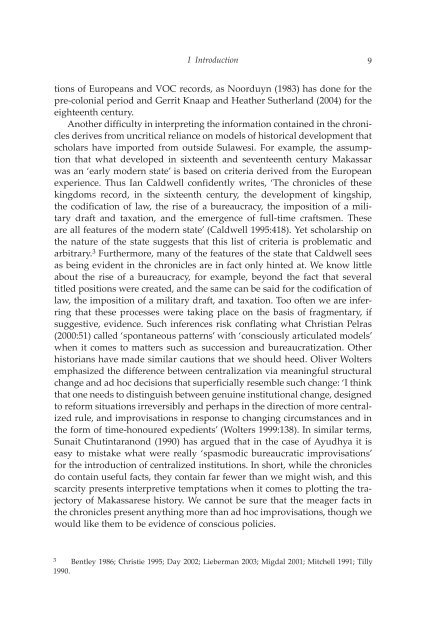A CHAIN OF KINGS - Books and Journals
A CHAIN OF KINGS - Books and Journals
A CHAIN OF KINGS - Books and Journals
Create successful ePaper yourself
Turn your PDF publications into a flip-book with our unique Google optimized e-Paper software.
I Introduction 9<br />
tions of Europeans <strong>and</strong> VOC records, as Noorduyn (1983) has done for the<br />
pre-colonial period <strong>and</strong> Gerrit Knaap <strong>and</strong> Heather Sutherl<strong>and</strong> (2004) for the<br />
eighteenth century.<br />
Another difficulty in interpreting the information contained in the chronicles<br />
derives from uncritical reliance on models of historical development that<br />
scholars have imported from outside Sulawesi. For example, the assumption<br />
that what developed in sixteenth <strong>and</strong> seventeenth century Makassar<br />
was an ‘early modern state’ is based on criteria derived from the European<br />
experience. Thus Ian Caldwell confidently writes, ‘The chronicles of these<br />
kingdoms record, in the sixteenth century, the development of kingship,<br />
the codification of law, the rise of a bureaucracy, the imposition of a military<br />
draft <strong>and</strong> taxation, <strong>and</strong> the emergence of full-time craftsmen. These<br />
are all features of the modern state’ (Caldwell 1995:418). Yet scholarship on<br />
the nature of the state suggests that this list of criteria is problematic <strong>and</strong><br />
arbitrary. 3 Furthermore, many of the features of the state that Caldwell sees<br />
as being evident in the chronicles are in fact only hinted at. We know little<br />
about the rise of a bureaucracy, for example, beyond the fact that several<br />
titled positions were created, <strong>and</strong> the same can be said for the codification of<br />
law, the imposition of a military draft, <strong>and</strong> taxation. Too often we are inferring<br />
that these processes were taking place on the basis of fragmentary, if<br />
suggestive, evidence. Such inferences risk conflating what Christian Pelras<br />
(2000:51) called ‘spontaneous patterns’ with ‘consciously articulated models’<br />
when it comes to matters such as succession <strong>and</strong> bureaucratization. Other<br />
historians have made similar cautions that we should heed. Oliver Wolters<br />
emphasized the difference between centralization via meaningful structural<br />
change <strong>and</strong> ad hoc decisions that superficially resemble such change: ‘I think<br />
that one needs to distinguish between genuine institutional change, designed<br />
to reform situations irreversibly <strong>and</strong> perhaps in the direction of more centralized<br />
rule, <strong>and</strong> improvisations in response to changing circumstances <strong>and</strong> in<br />
the form of time-honoured expedients’ (Wolters 1999:138). In similar terms,<br />
Sunait Chutintaranond (1990) has argued that in the case of Ayudhya it is<br />
easy to mistake what were really ‘spasmodic bureaucratic improvisations’<br />
for the introduction of centralized institutions. In short, while the chronicles<br />
do contain useful facts, they contain far fewer than we might wish, <strong>and</strong> this<br />
scarcity presents interpretive temptations when it comes to plotting the trajectory<br />
of Makassarese history. We cannot be sure that the meager facts in<br />
the chronicles present anything more than ad hoc improvisations, though we<br />
would like them to be evidence of conscious policies.<br />
3 Bentley 1986; Christie 1995; Day 2002; Lieberman 2003; Migdal 2001; Mitchell 1991; Tilly<br />
1990.









![Am HaSefer [Volk des Buches] - Books and Journals](https://img.yumpu.com/20648352/1/174x260/am-hasefer-volk-des-buches-books-and-journals.jpg?quality=85)







